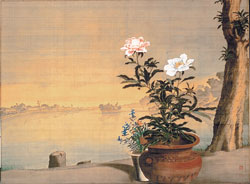| architecture |
| calligraphy |
| ceramics |
| clothing |
| comics |
| gardens |
| lacquerwork |
| literature |
| movies |
| music |
| painting |
| poetry |
| sculpture |
| tea ceremony |
| television |
| theatre |
| weaponry |
| thematic routes |
| timeline |
| the site |
context: painting > general comments
Western influence

|
Shinobazu-no-ike Pond by Odano Naotake in the 1770s |
The first contact with the West came with the arrival of Portugese missionaries in the 16th Century, and this started a rather turbulent relationship. At first, Europeans were permitted to proselytise, until the Japanese got wind of what had followed this in many other countries, and first banned Christianity, then Europeans too. There had been great interest when they first arrived on all kinds of levels - firearms changed combat completely, and therefore affected castle architecture, and oil paint and the use of shading and linear perspective were of interest in artistic circles, though there was rather a sense from most artists of these things being cute gimmicks, to be toyed with occasionally but not to be taken seriously.
The isolation of Japan from 1639 made foreigners exotic curiosities, and they appear here and there in art, as do their ideas. You can see an example of uki-e, the perspective print, but the deeper effects on Japanese art took a little longer to show up - but before the end of the 18th Century, there were entirely Western style artists in Japan, often still painting with watercolours on silk, but going for a European oil painting style. Odano Naotake is the classic example of this.
